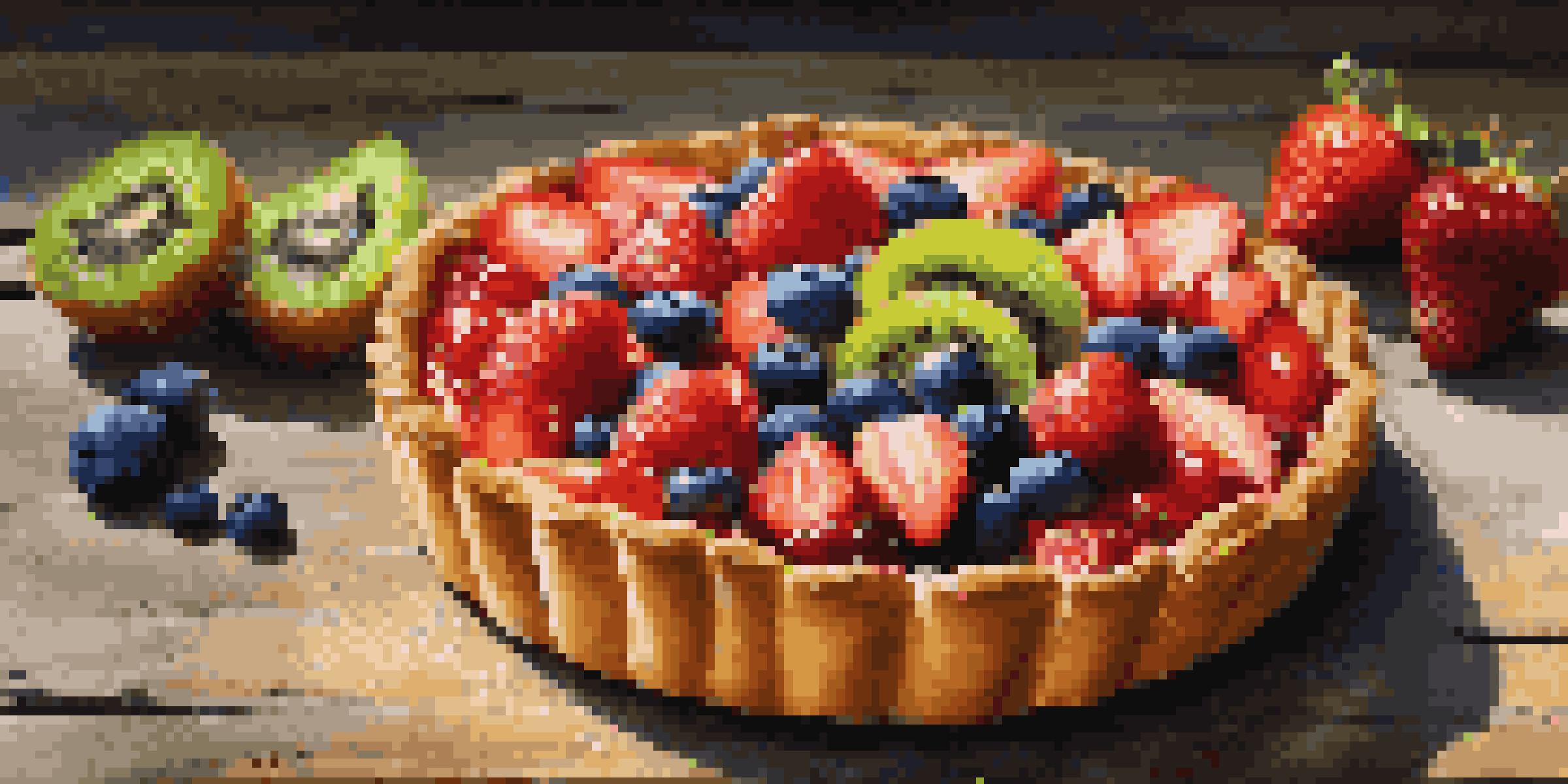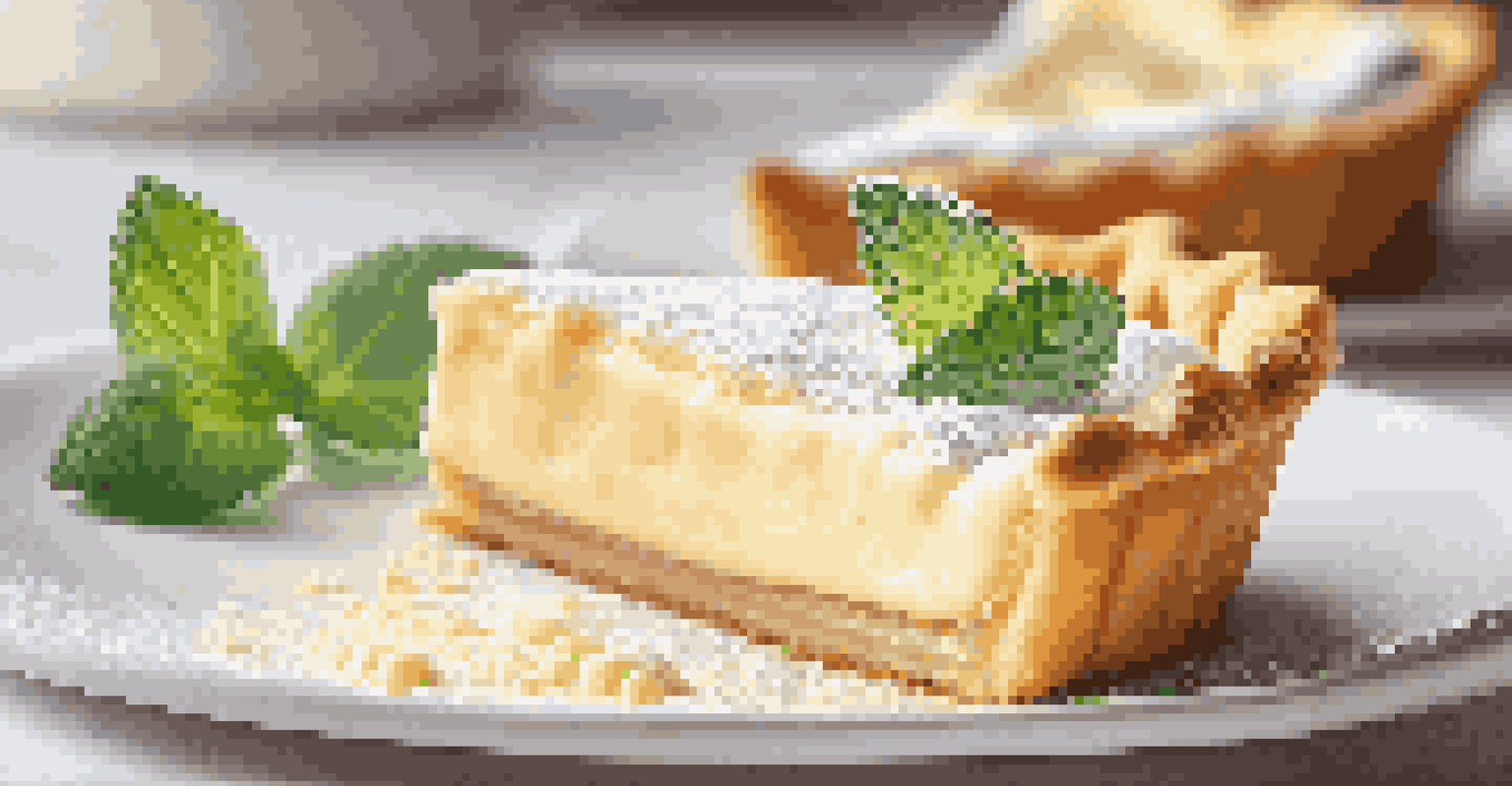The Art of Pâte Sucrée: Making the Perfect Sweet Tart Crust

Understanding Pâte Sucrée: A Sweet Tart Crust Defined
Pâte sucrée, or sweet pastry dough, is a foundational element in baking. This delightful crust is known for its sweet flavor and tender texture, making it the perfect base for fruit tarts, cheesecakes, and more. Unlike other doughs, it’s enriched with sugar and fat, giving it a unique richness that elevates any dessert.
Baking is both an art and a science. It requires precision, but it also allows for creativity and personal expression.
The beauty of pâte sucrée lies not just in its taste, but also in its versatility. Whether you're filling it with creamy custards or fresh fruits, this crust complements a variety of fillings while holding its shape beautifully during baking. It's a beloved choice among pastry chefs, and once you master it, you’ll see why.
Think of pâte sucrée as a canvas for your sweet creations. When executed correctly, it provides both a delightful crunch and a melt-in-your-mouth experience. By understanding its components, you're on your way to creating stunning desserts that will impress both family and friends.
Gathering Your Ingredients: What You’ll Need
To create the perfect pâte sucrée, you need a handful of simple ingredients. The basic components include all-purpose flour, powdered sugar, unsalted butter, an egg yolk, and a pinch of salt. Each element plays a crucial role in achieving that ideal texture and flavor.

Using cold, unsalted butter is key to ensuring a flaky crust. The powdered sugar, on the other hand, helps create a finer texture compared to granulated sugar, which can make the crust gritty. Lastly, the egg yolk binds the ingredients together while adding richness.
Pâte Sucrée: The Sweet Crust
Pâte sucrée is a versatile sweet pastry dough that serves as an ideal base for various desserts like tarts and cheesecakes.
It’s essential to use high-quality ingredients. Fresh butter and flour can make a significant difference in the final product. So, take a moment to gather the best ingredients you can find, and you’ll be rewarded with a crust that tastes as good as it looks.
Mixing the Dough: Techniques for Success
Mixing pâte sucrée requires a delicate touch, and it all starts with the butter and sugar. Begin by creaming the softened butter and powdered sugar together until the mixture is light and fluffy. This process incorporates air, which helps create a tender crust.
The greatest dishes are very simple.
Once combined, it’s time to add the egg yolk and mix until just blended. Avoid overmixing at this stage, as this can lead to a tough crust. Next, gently fold in the flour and salt until the mixture is just combined. You want to see a few streaks of flour remaining, as this will help maintain that tender texture.
After mixing, it's essential to chill the dough. Wrap it in plastic wrap and let it rest in the refrigerator for at least 30 minutes. This step not only helps the flavors meld but also makes the dough easier to roll out later.
Rolling and Shaping: Creating the Crust
When it’s time to roll out your pâte sucrée, ensure your work surface is lightly floured. Start by gently pressing the dough into a flat disc with your hands before using a rolling pin. This initial flattening helps reduce cracking as you roll it out.
Roll the dough into a circle, aiming for about 1/8-inch thickness. If the dough becomes too sticky, add a sprinkle of flour to your surface and the rolling pin. Remember, it’s okay if your circle isn’t perfect; the beauty of homemade pastries often lies in their rustic charm.
Key Techniques for Mixing Dough
Mixing pâte sucrée requires a gentle approach, emphasizing the importance of not overmixing to maintain a tender texture.
Once rolled out, transfer the dough to your tart pan. Gently drape it over the pan, then press it into the corners and edges. Trim any excess dough hanging over the sides, and if you wish, you can use a fork to create decorative designs or to dock the bottom, which helps prevent bubbles during baking.
Blind Baking: Ensuring a Crisp Crust
Blind baking is the technique used to pre-bake your crust before adding any filling. This step is crucial for achieving that perfectly crisp tart shell, especially for fillings that don’t require additional baking. It helps to prevent a soggy bottom, which can be the downfall of many a tart.
To blind bake, line the crust with parchment paper and fill it with pie weights or dried beans. This weight keeps the dough from puffing up as it bakes. Place the tart shell in a preheated oven and bake for about 15-20 minutes, or until the edges are lightly golden.
After the initial baking, remove the weights and parchment, then return the crust to the oven for a few more minutes to ensure the bottom is fully cooked. This simple technique makes a world of difference in the final texture of your tart.
Filling Options: Let Your Creativity Shine
Now that you have a beautifully baked pâte sucrée, it’s time to fill it! The options are nearly endless, from classic pastry cream to vibrant fruit compotes. For a traditional approach, a rich pastry cream infused with vanilla is always a crowd-pleaser.
If you’re feeling adventurous, consider seasonal fruits like berries, peaches, or citrus. Fresh fruit tarts not only taste incredible but also look stunning when garnished with a glaze or whipped cream. Each filling brings its own flavor profile and texture, allowing for endless creativity in the kitchen.
Creative Filling Options Abound
From classic pastry cream to seasonal fruits, the filling possibilities for pâte sucrée are endless, encouraging culinary creativity.
Don’t forget about the possibility of savory tarts as well! By adjusting the sugar and adding ingredients like cheese or vegetables, you can create a unique spin on the pâte sucrée that surprises and delights your guests.
Storing and Serving: Enjoying Your Tart
Once your tart is filled and ready to go, consider how to best store it. If you plan to serve it later, refrigerate the tart to keep the filling fresh. Most sweet tarts can last up to three days in the fridge, but they are best enjoyed within the first day or two for optimal flavor and texture.
When it comes to serving, presentation is key! Consider garnishing your tart with fresh herbs or a dusting of powdered sugar for an elegant touch. Slicing your tart with a hot knife can produce clean cuts, making each piece as beautiful as it is delicious.

Finally, gather your friends and family around to share your creation. There’s nothing quite like the joy of serving a homemade dessert, and with your perfect pâte sucrée, you’ll surely impress everyone at the table.